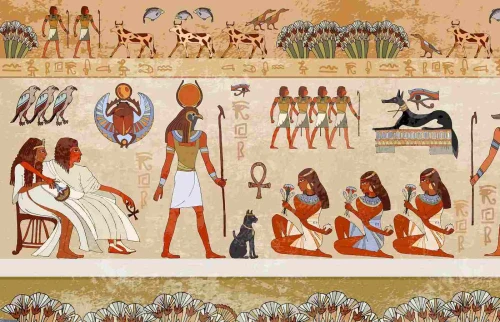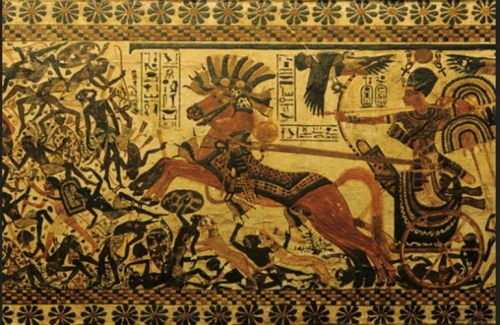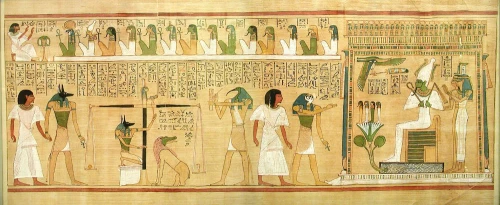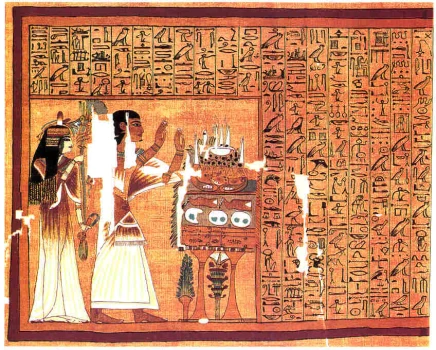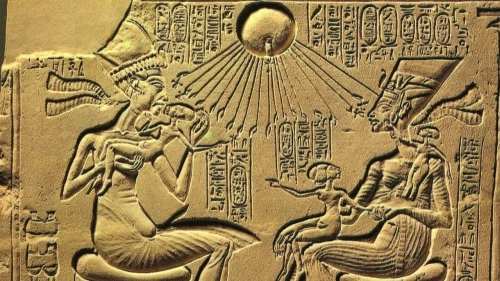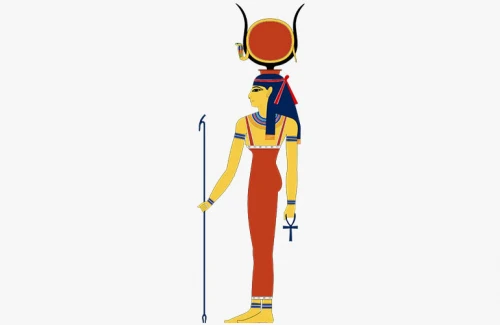
HATHOR 4 One the oldest and most beloved goddesses in ancient Egypt, Hathor is the universal cow goddess and a symbolic mother of the pharaoh. Her image has been found carved on early flint implements, and her cow head is prominent on the Narmer Palette (c. 3100 B.C), a commemorative slate palette recording a victorious battle of King Narmer. The goddess Hathor is represented in many different ways. She is the "Great Wild Cow". and her home was the papyrus thicket, where the papyrus plant was sacred to her. When Hathor appeared as a cow-headed woman, she was crowned with the sun disk resting between her cow horns, and in her hands, she held a WAS or papyrus scepter. In her temples, Hathor-headed columns with human faces were incorporated into the architecture. So important was Hathor in the Egyptian pantheon that eventually every other goddess, even Isis, sometimes called Hathor-Isis, was identified with her. The cow-goddess cult was well established even in Predynastic Egypt (5500 - 3100 B.C), and Hathor must have shared attributes with other minor cow goddesses, such as the Predynastic goddess Bat. Hathor is mentioned in the Old Kingdom (2686–2181 b.c.) valley temple of King Chephren as a guardian of the temple. She was so popular with the people that shrines to the great goddess could be found in almost every town. Because of her many attributes, Hathor became the great mother goddess of this world and the next, and her titles and her characteristics grew too numerous to list. In each of the nomes of Upper and Lower Egypt, Hathor was identified with the local goddess and showered with loving epithets. In Memphis, she was known as the Lady of the Sycamore. As the Lady of Turquoise she was worshipped at Serabit.
el Khadim in the Sinai, a remote region in the desert. The remains of her temple can still be seen high on the mountaintop, where it was one of the few Egyptian temples built on foreign soil. Hathor was the patron goddess of the miners digging for turquoise, a stone highly prized in ancient Egypt. When Hathor was honored as the Lady of the Underworld she wore meat, a counterpoise, or balance, to a large necklace. The menat, a symbol of
the goddess represented pleasure and joy. During cult ceremonies, the menat, often decorated with the face of Hathor, was carried and shaken as an accompaniment to chanting and singing. One of Hathor many titles is Golden One, referring to her special association with gold and precious metals. Highly polished hand mirrors were often made from gold or bronze and were decorated with the image of Hathor, reflecting her association with Re the sun god. The name Hathor means House of Horus and, as a goddess of the sky, she personified the house and sky of Horus (the hawk) when he is portrayed as the sun god. Horus himself was the oldest form of the sun god, and Hathor is his wife. Since the king was closely identified with Horus (one of his five titles was his golden Horus name), Hathor became the divine mother and protector of the king. This relationship is illustrated in the statue of Amenhotep II (1427 - 1400 B.C) being nursed by his divine mother, Hathor, now in the Egyptian Museum in Cairo. Hathor is also the daughter of the great sun god Re, and mythology tells us that when he called upon her, she became the vengeful eye of her father, Re, bringing violence and destruction wherever she went. When Re wished to destroy humankind, he sent Hathor, as his vengeful eye, to carry out the slaughter. One ceremony in the Hathor cult involved pacifying her dangerous side by playing the sistrum, a rattle, something like a tambourine, one of Hathor's ritual objects. Love, Music, and Dance As the personification of female sexuality, love, music, dance, and drink, Hathor was seen by the Greeks to be the same as their goddess of love, Aphrodite. The cult of Hathor focused on pleasure, and the rituals involved sensual music and dancing. As shown on tomb walls, dancing in honor of Hathor was part of joyous celebrations, of which music was an important part. Ritual music was accompanied by the sistrum and the meat, both of which were shaken with great enthusiasm during processions. The sistrum, a rattle with a long handle, was often decorated with a Hathor head. As a nurturing goddess, Hathor was sought as a bringer of fertility and a protector of women in childbirth. It was believed that Hathor could predict the destiny of a newborn child. Hathor also was a mortuary goddess, and in Thebes, she was known as the Lady of the Western Mountain. In one myth, each night Hathor protects the evening sun while the deceased offers prayers to Hathor, the goddess of love and music, was called the Lady of Heaven. She wears a metal necklace around her neck. (Drawing by Mary Jordan)
be in the following of Hathor, or to avoid eternal darkness. Hathor's main temple was in Dendera, where she was worshipped with Horus of Edfu and their son Ihy.
 English
English
 Spain
Spain

